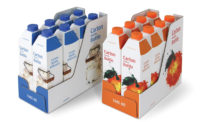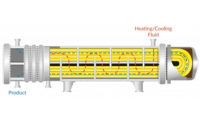Secondary packaging becomes a more dynamic dairy processing component
Upgrades are keeping pace with the greater sector demand for eco-friendly designs with added product safeguards.

Photo courtesy of endopack via geetyimages.com.
When it comes to protecting dairy products, the importance of secondary packaging is far from secondary.
The packaging, which processors are using to transport and store the so-called primary packaging that is in direct contact with the product itself and most visible to the consumer, is playing an increasingly essential role in food safety and supply chain operations.
Secondary packaging includes such options as folding cartons, corrugated boxes, plastic crates, wraps, and films, and demand for the selections is on the upswing.
The overall secondary packaging market is forecast to grow by $72.19 billion from 2023 to 2027 with an estimated compound annual growth rate of 4%, states Technavio, an Elmhurst, Ill.-based global technology research and advisory company. Growth drivers include the increasing demand for sustainable packaging; greater interest in processed and packaged foods; and an expanding e-commerce sector, the firm states.
“New packaging materials and packaging design innovations have increased the use of innovative secondary packaging solutions to ensure product safety and extended shelf life,” Technavio notes.
A growing demand for lightweight materials is the primary trend shaping the secondary packaging market, the firm reports, adding that more manufacturers are switching to plastic, paper, and cardboard containers to reduce packaging weight and using high-performance lightweight paper and paperboard containers that are cost-effective and environmentally friendly.
“The increased demand for environmentally friendly packaging solutions is expected to drive growth in the secondary packaging market,” adds Mordor Intelligence, a Hyderabad, India-based market research and consulting firm. “Furthermore, stringent government regulations requiring sustainable packaging solutions are projected to benefit the secondary packaging market, driving reusable and recyclable materials in the coming years.”
Operators often use secondary packaging machines to collect individual packages and place them in cartons that will eventually find their way onto pallets and undergo shrink wrapping and transport to a warehouse or distribution center, Mordor Intelligence states.
Resilience is a requisite
“They will eventually be delivered to a retail outlet where the pallet will be broken down, cartons opened, and individual packages placed on the shelf,” Mordor reports. “In other words, the secondary package is well-traveled and needs to be able to stand up to a lot of over-the-road abuse.”
Indeed, it is vital that secondary packaging has the strength and flexibility to protect dairy products in primary packaging to enhance food safety and quality, says Richard Stier, a Sonoma, Calif.-based consulting food scientist.
“It is up to the processors’ packaging engineers to establish specifications for the secondary packaging to ensure that it will withstand the rigors of shipping and handling,” he states. “To do this, they need to understand how the products will be shipped.”
In some circumstances, for instance, operators may risk damage by stacking pallets containing the secondary packaging two-high during shipping and warehousing. “Many processors skimp on package fiber strength,” Stier says. “The end result is having products that are crushed and occasionally leaking.”
To reduce the chance of destruction, some operators are placing an inked label or tag on each container warning against the double stacking of pallets while providing handling information, he states.
Processors also are marking secondary packaging with such instructions as “store in a cool, dry place” or “keep refrigerated” to strengthen product quality and safety, Stier says.
Adding a tag or inked codes to secondary packaging also can enable more precise product identification and traceability, he states. Data can include the product name, lot code, a UPC barcode, pack date, company name and a time stamp. “This information can be invaluable when troubleshooting problems,” Stier says.
More secondary packaging designs also are containing less material to reduce waste and labor requirements, while featuring technologies that enable processors to better track packages along the supply chain, says John Blake, senior director analyst, packaging and label artwork management, for Gartner Inc., a Stamford, Conn.-based technological research and consulting firm.

Automation comes of age
Robotics and vision systems, meanwhile, are adding flexibility to operations by enabling users to switch to different secondary packaging sizes, formats, and materials with greater speed and precision, says Jorge Izquierdo, vice president of market development for Herndon, Va.-based PMMI: The Association for Packaging and Processing Technologies. A vision system combines cameras, lenses, and lighting to automate visual inspections of manufactured products.
Technological advancements also are enabling dairy manufacturers to use the same machine for a greater variety of secondary packaging applications by providing quick changeover capabilities, he notes, which is decreasing equipment expenditures and increasing operational efficiencies.
That is important as products in varying types of primary packaging often require specific secondary packaging designs, Izquierdo says. He notes that the wide array of primary packaging can range from single-serve containers that are common in convenience stores to the popular multi-pack assortments in warehouse clubs.
Additional improvements to secondary packaging systems include the development of print-and-apply labeling equipment that can operate at higher volumes; equipment that requires less maintenance and operator intervention during production; better barcode quality; and the ability to accurately label packaging items, such as shipping cases and shrink-wrapped trays, when product handling is imperfect, says David Holliday, director of marketing communications for Covington, Ky.-based packaging systems developer ProMach Inc.’s ID Technology brand.
“One of the problems labeling systems for secondary packaging face is that the products are not always presented to the labeler consistently,” he notes. “This is especially true with older production lines.”
Design enhancements also are enabling dairy processors to use modern labeling equipment on legacy packaging lines, which increases output without significant changes to product handling, Holliday says.
In addition to incorporating state-of-the-art secondary packaging technologies, processors can enhance operations by leveraging overall equipment effectiveness (OEE) measures to reduce unplanned downtime and decrease stops for label roll replenishment, he notes. The OEE methodology identifies the percentage of manufacturing time that is productive.
Getting processor production teams, line operators, and maintenance workers up to speed with the newer technologies, however, can be daunting if packaging or labeling equipment are difficult to use and maintain, Holliday says, adding that processors should seek equipment that is “easy to work without additional complexity.”

Evaluate the alternatives
Dairy processors, meanwhile, should take an “end-to-end” view and consider such issues as labor shortages, rising costs, and the ongoing emphasis on sustainability and the circular economy in determining the most effective secondary packaging systems to incorporate in their operations, Blake states.
“A challenge is to look beyond initial investments and uncover all the potential supply chain benefits of optimal secondary packaging systems,” he notes. Such a system may include the use of track and trace technology to provide “visibility of the packaging assets and real-time location of finished goods.”
A track-and-trace system can monitor vehicles, loading units, shipments, and products throughout the supply chain.
Organizations seeking the most efficient and functional secondary packaging systems should initially assemble a team to assess secondary packaging opportunities, engage stakeholders, and then prepare to share the business case, Blake says.
“The next step is to evaluate the available technologies, initiate pilots, and develop an ecosystem of partners, which can include vendors, customers, and, in some cases, even competitors,” he notes.
Indeed, Blake says it is important that operators avoid the temptation to solve all secondary packaging issues internally. “Processors should reach out to vendor experts and start the conversation,” he states. “There are often multiple players in a successful fully vetted process.”
Ongoing changes in packaging specifications, meanwhile, are a major issue for processors seeking to enhance their secondary packaging technologies, Izquierdo states. “As packaging systems are optimized for specific formats, materials, and speeds, significant changes in any of these will impact the productivity of the packaging equipment,” he notes.
To keep pace with such developments, operators should determine the necessary specifications for packaging formats, materials, layouts, and speeds early in an initiative and share the information with suppliers of materials, converters, and equipment “so they can provide the best solution upfront rather than making adaptations at later stages,” Izquierdo states.
Processors, meanwhile, can use OEE to help determine the most effective secondary packaging system for their specific situations, Izquierdo notes.
“It is a good way to evaluate an investment; understand the implication of materials, labor, and equipment; help users realize opportunities for savings in the production processes; and maximize efficiency on the plant floor,” he states.

Sustainability picks up speed
Moving forward, the rising cost of raw materials will remain a major operational challenge for secondary packaging users, Technavio states. The firm notes, for instance, that prices for paper pulp have been increasing because of supply issues, and higher resin prices are resulting in greater costs for plastic packaging.
A stronger eco-conscious also will impact the secondary packaging sector.
“With growing concerns about climate change and the negative environmental impact of plastic materials, many businesses and consumers are turning to more sustainable packaging solutions such as paper,” Technavio states. “Paper-based packaging materials are primarily sourced from renewable sources, such as trees from responsibly managed forests, and are readily recycled or biodegradable.” The food and beverage industry is one of the largest users of paper secondary packaging, the firm notes.
Blake adds that an industry emphasis on reusable secondary packaging will become increasingly important. “Much of that will be driven by expectations of increased legislation,” he notes. “With that comes opportunities to incorporate visibility tools such as track and trace and data monitoring to manage not only products but the packaging assets to transport them.”
Looking for a reprint of this article?
From high-res PDFs to custom plaques, order your copy today!






